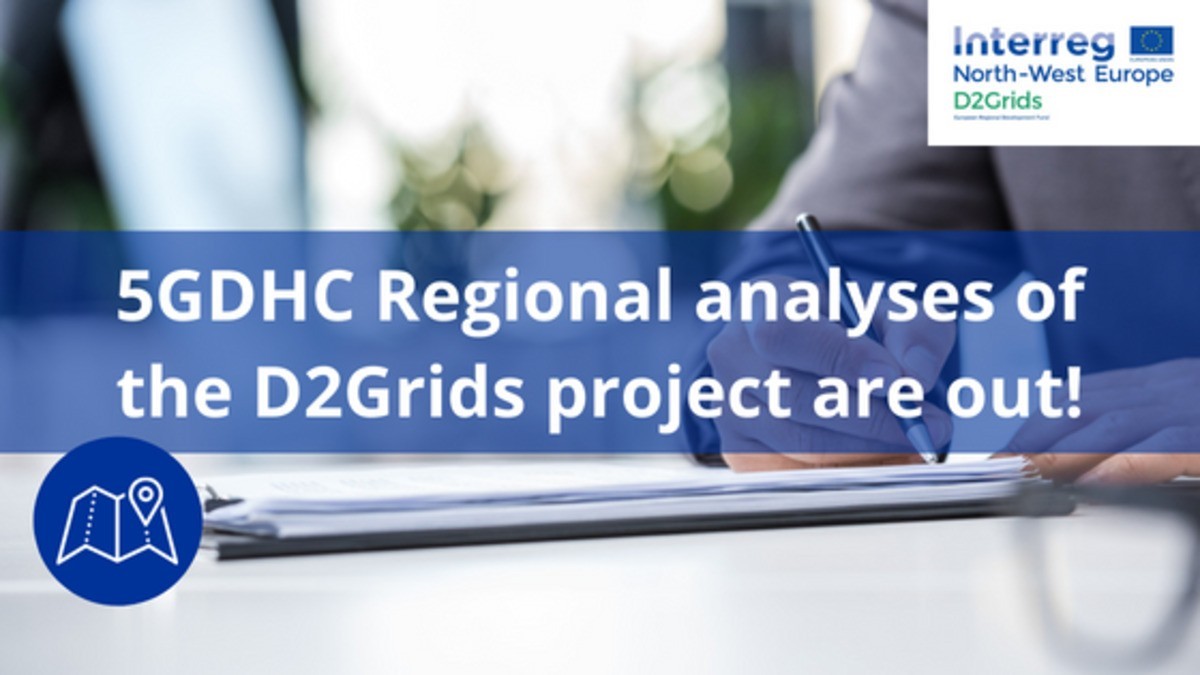5GDHC Regional analyses of the D2Grids project are out!
D2Grids Project

D2Grids project has the ambition to sustain and roll-out the outputs and activities of the project to a wide variety of target groups, including policymakers, financial investors, professionals, SMEs, and other companies in the DHC industry.
Transnational roll-out beyond pilot sites will be facilitated by a regional vision development and
preliminary feasibility assessment for rolling out 5GDHC technology. It has been carried by project
partners in each of the 7 follower regions defined for the project, namely: Parkstad Limburg (NL);
North-East France; Luxembourg; Flanders (BE); Ruhr-area (DE); Scotland; East Midlands (UK). It
aims to define ambitions for low-carbon heating and cooling and to assess the feasibility and
potential of 5GDHC's roll-out.
The regional visions that are now available for public use consist of 5 categories: renewable
sources; existing infrastructure and planned developments; thermal demand and supply profiles;
legal and policy framework; financing options.
These assessments aim to find the potential of deploying 5GDHC in the follower regions after the
project ends. This is done by mapping strengths, weaknesses, opportunities and barriers (SWOT) of
5GDHC for each of the regions. Some examples from these SWOT analyses can be found below:
One important common opportunity for 5GDHC roll-out comes from the current energy crisis in
Europe, which has been a driving force for the acceleration of gas-free policies and programmes.
Due to high energy prices, and countries paying higher prices for gas in Europe, together with
geopolitical risks associated with natural gas, district heating grids become more interesting for
policy makers as well as for citizens.
Many regions are also looking to reduce their energy consumption, increase the share of renewable
heat and electricity production and to go towards energetic sobriety. All those objectives fixed in
the energy plans are compliant with 5GDHC principles.
It was also noted that densely populated areas present a good potential for 5GDHC development,
as they are better qualified to comply with one of the 5 principles of 5GDHC: “Local sources as a
priority”. It helps to decrease or even avoid energy losses during transport.
On the other hand, it is also important to note some of the threats for 5GDHC in these regions, for
instance, the lack of balancing needs between heating and cooling, which is one of the main
concepts defining 5GDHC. In North-West Europe, the demand for cooling is currently relatively low
compared to heating, however, the heat waves in recent years raised the awareness that cooling is
or will be needed in summer, for housings and especially for tertiary buildings (offices, hospitals,
schools, shops, etc.), presenting new opportunities for 5GDHC.
Another threat can be the already existing grids for high temperature district heating. However, an
opportunity can also be found here through the concept of ‘cascading’. In areas where there is a lot
of high temperature residual heat, it could be interesting to keep using that heat in 3-4 GDH grids
that need to supply higher temperature demand. The heat in the return pipes could then be used as
an input for a 5GDHC grid, optimizing the use of energy.
In all the regions it is important to note the lack of policies and of examples other than the D2Grids
pilots and very few others, which results in a knowledge gap for the technology from the side of
industry, policymakers, citizens, and other stakeholders. Hopefully, the regional visions now
available will help filling this gap and provide at least these 7 regions with more information and
tools for their transition to 5GDHC.
We have compiled all the analyses in the PDF document below!
You will find:
Page 1: East-Midlands' regional analysis
Page 32: Flanders' regional analysis
Page 82: France's regional analysis
Page 138: Luxemburg's regional analysis
Page 156: Parkstad's regional analysis
Page 212: Ruhr Area's regional analysis
Page 249: Scotland's regional analysis
paul.capgras[a]construction21.fr




